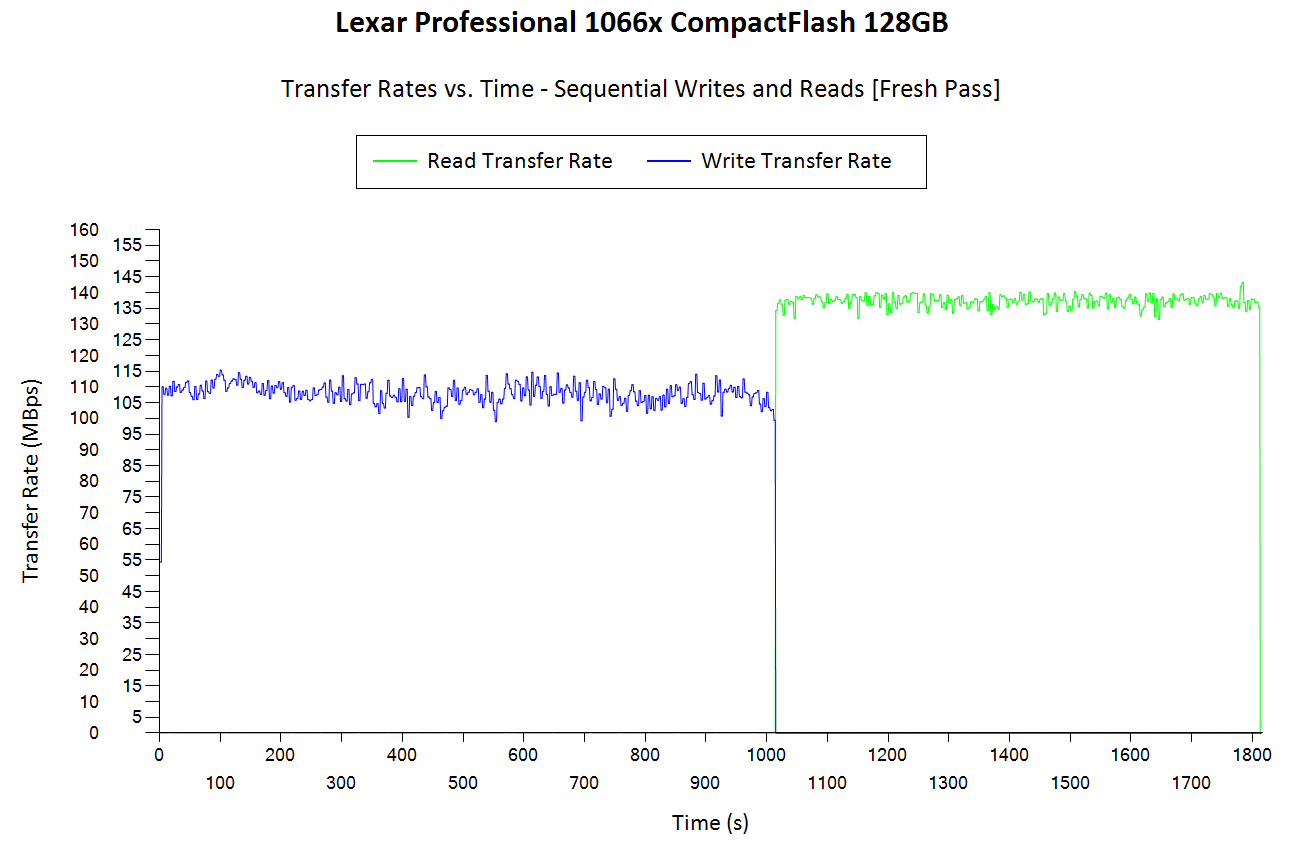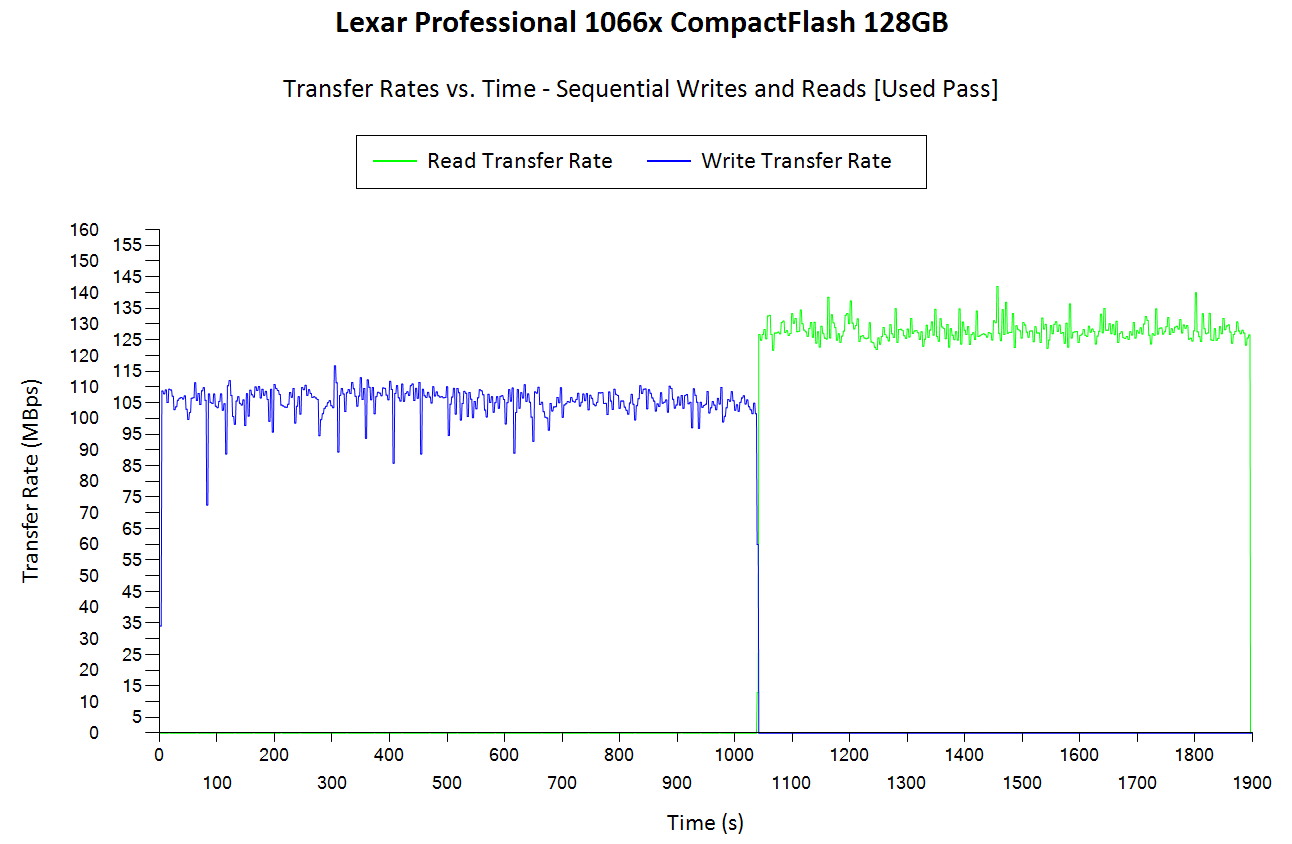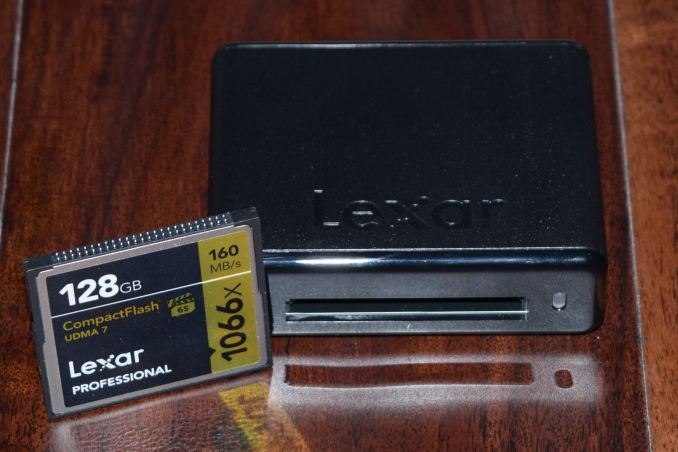Lexar Professional Workflow HR2 4-Bay Thunderbolt 2 / USB 3.0 Reader Hub Review
by Ganesh T S on June 22, 2017 8:00 AM ESTLexar Professional 1066x CompactFlash Performance
CompactFlash (CF) was introduced back in 1994 as a mass storage device format, and it turned out to be the most successful amongst the first set of such products. Electrically, it is based on a parallel ATA (PATA) interface.
Lexar offers cards in the 1066x series in capacities ranging from 16GB to 256GB. The first CF card to be subject to our memory card review workflow is the Lexar Professional 1066x 128GB card (LCF128CRBNA1066).
Sequential Accesses
Lexar claims speeds of up to 160 MBps reads and 155 MBps writes, but real-world speeds are bound to be lower. In fact, writes can sometimes be much slower. For most applications, that really doesn't matter as long as the card is capable of sustaining the maximum possible rate at which the camera it is used in dumps data. We use fio workloads to emulate typical camera recording conditions. We run the workload on a fresh card, and also after simulating extended usage. Instantaneous bandwidth numbers are graphed. This gives an idea of performance consistency (whether there is appreciable degradation in performance as the amount of pre-existing data increases and / or the card is subject to wear and tear in terms of amount and type of NAND writes). Further justification and details of the testing parameters are available here.


We find that write consistency takes a slight hit after extended usage. The minimum write speed for a fresh card appears to be around 95 MBps, while it can drop down to around 75 MBps after extended usage. Reads take a slight hit in the actual bandwidth value (from around 135 MBps to 130 MBps), but there is no issue with consistency.
AnandTech DAS Suite - Performance Consistency
The AnandTech DAS Suite involves transferring large amounts of photos and videos to and from the storage device using robocopy. This is followed by selected workloads from PCMark 8's storage benchmark in order to evaluate scenarios such as importing media files directly into multimedia editing programs such as Adobe Photoshop. Details of these tests from the perspective of memory cards are available here.
In this subsection, we deal with performance consistency while processing the robocopy segment. The graph below shows the read and write transfer rates to the memory card while the robocopy processes took place in the background. The data for writing to the card resides in a RAM drive in the testbed. The first three sets of writes and reads correspond to the photos suite. A small gap (for the transfer of the videos suite from the primary drive to the RAM drive) is followed by three sets for the next data set. Another small RAM-drive transfer gap is followed by three sets for the Blu-ray folder.

The Lexar 1066x CF card has absolutely no trouble in exhibiting consistent performance while transferring data to and from it even under sustained conditions with a mixture of file sizes. From a primary use-case perspective, this is more to simulate extended usage.
AnandTech DAS Suite - Bandwidth
The average transfer rates for each workload from the previous sub-section is graphed below. Readers can get a quantitative number to compare the Lexar 1066x 128GB CF card against the ones that we have evaluated before (currently, none).






We also look at the PCMark 8 storage bench numbers in the graphs below. Note that the bandwidth number reported in the results don't involve idle time compression. Results might appear low, but that is part of the workload characteristic. Note that the same testbed is being used for all memory cards. Therefore, comparing the numbers for each trace should be possible across different cards (once we add more cards to the benchmarked list).








Performance Restoration
The traditional memory card use-case is to delete the files on it after the import process is completed. Some prefer to format the card either using the PC, or, through the options available in the camera menu. The first option is not a great one, given that flash-based storage devices run into bandwidth issues if garbage collection (processes such as TRIM) is not run regularly. Different memory cards have different ways to bring them to a fresh state.Based on our experience, CF cards have to be formatted after all the partitions are removed using the 'clean' command in diskpart.
In order to test out the effectiveness of the performance restoration process, we run the default sequential workloads in CrystalDiskMark before and after the formatting. Note that this is at the end of all our benchmark runs, and the card is in a used state at the beginning of the process.

Simple non-sustained workloads are not at all problematic for the Lexar CF card even after extended usage. Therefore, restoring to the fresh state only brings out a minor increase in the read performance.
Pricing
In addition to raw performance and consistency, pricing is also an important aspect. This is particularly important in the casual user and semi-professional markets, where the value for money metric often trumps benchmark numbers. The table below presents the relevant data for the Lexar 1066x 128GB CF card.
| CF Cards - Pricing (as on June 15, 2017) | ||||
| Card | Model Number | Capacity (GB) | Street Price (USD) | Price per GB (USD/GB) |
| Lexar 1066x 128GB | LCF128CRBNA1066 | 128 | 110 | 0.86 |











32 Comments
View All Comments
romrunning - Thursday, June 22, 2017 - link
It would be a nicer product if it supported Thunderbolt 3.romrunning - Thursday, June 22, 2017 - link
... and while we're at it, USB 3.1 Gen2. That would make it a more usable hub for me.ganeshts - Thursday, June 22, 2017 - link
Definitely.. but, as I mentioned in the concluding section, we are reviewing a product that is almost 3 years old now :) (it is in our review table for an additional reason - allowing us to evaluate memory cards from different vendors). The next iteration should bring about USB 3.1 Gen 2 (which should be more than good enough bandwidth-wise) and / or Thunderbolt 3 (which should enable daisy-chaining with other equipment)Morawka - Thursday, June 22, 2017 - link
adds costs and the speed is not needed unless your flashing to a RAID 5 Array of SSD'sSamus - Thursday, June 22, 2017 - link
Wow, I didn't even know something like XQD existed. That's a pretty badass format (PCIe) considering it dates back to 2010.Grammar polic3 - Friday, June 23, 2017 - link
"There product lines include memory cards, USB flash drives, card readers, and external SSDs."You should have started the sentence with "their".
ganeshts - Friday, June 23, 2017 - link
Unpardonable mistake. Not sure how that sneaked into the piece. I have changed it.Wolfpup - Friday, June 23, 2017 - link
The...I don't know what you call them, but the readers that can plug in to the dock also work on their own. I've been using an SD card one on it's own for several years, use it to use an SC card to sync some stuff between work and home, and the setup works great.cfenton - Sunday, June 25, 2017 - link
I like seeing SD card reviews.Just a few typos/errors to point out:
1. On the 1000x SDXC page it says "From write speeds of aroun 100 MBps, we drop down to 16 MBps."
2. The graphs in the PCMark 8 section of the CFast page seem to be flipped around. It shows that the card has much faster write speeds than read speeds, while all the other charts on the page show the opposite.
jonny13 - Tuesday, June 27, 2017 - link
Funny how this review comes out before Micron takes the ax to Lexar and shuts down the product line, which sucks as I had gone to all Lexar products in my cameras as they are much more reliable and faster than Sandisk.RIP Lexar
https://www.micron.com/about/blogs/2017/june/micro...